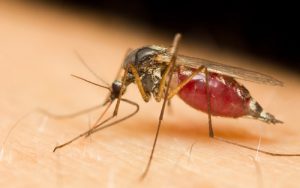How to Eliminate Mosquitoes From Your Yard – Advice From the Pros
By Chris Williams on June 3, 2011.
Too many people don’t understand the connection between mosquito problems and standing water. Mosquitoes need water to develop. The first three life stages of mosquitoes (egg, larva, and pupa) occur in water. The adult mosquito is the only stage that doesn’t live in water. But most female mosquitoes look for still and stagnant water in containers like old buckets and cans, even tires and boats, in which to lay their eggs.
If you’re being bitten by mosquitoes in your yard, you can be sure that there is a source of standing water nearby that is breeding mosquitoes. Sometimes that water source is obvious (with a little looking) and easily eliminated. For example, a wheelbarrow full of rainwater that can easily be dumped. Other times, the water source may be larger, or farther away, or something that can’t be treated at all such as a marshy area on a neighbor’s farm.
 In most cases, homeowners are creating their own mosquito problems but are the last to realize it. The typical suburban backyard can generate thousands of adult mosquitoes in a week. Take a tour of your property and look for anything that could be holding rain or irrigation water. You’ll be able to see the mosquito larvae (“wigglers”) hanging from the surface of the water, or the darker pupae (“tumblers”) moving up and down in the water. Below are some of the typical mosquito breeding sites in a typical yard:
In most cases, homeowners are creating their own mosquito problems but are the last to realize it. The typical suburban backyard can generate thousands of adult mosquitoes in a week. Take a tour of your property and look for anything that could be holding rain or irrigation water. You’ll be able to see the mosquito larvae (“wigglers”) hanging from the surface of the water, or the darker pupae (“tumblers”) moving up and down in the water. Below are some of the typical mosquito breeding sites in a typical yard:
Cans and buckets. Discard them, store them inside, or turn them upside down.
Old tires. Store in a basement or shed or cover them with a tarp.
Barrels and garbage cans. Drain them and store tightly covered or upside down.
Roof gutters. Clean out leaves and debris that trap and hold water.
Bird baths. Change and clean the water every few days.
Wading pools. Change the water frequently. Turn upside down when not in use.
Canoes and boats. Cover with a tarp, turn upside down, or open drain plugs.
Ornamental ponds. Stock with small fish that will eat developing mosquitoes.
Puddles and swampy areas. Grade to drain off the water, or fill with dirt.
Flower pots/vases. Drain water from pot saucers. Change water in vases often.
Leaky faucets and hoses. Repair leaking faucets and drain area beneath.
Tarps or plastic sheets. Pull coverings tight and slope them so water drains off.
Pet water bowls. Empty frequently, clean, and refill.
Wheelbarrows. Store under cover in basement or shed, or upside down.
Drainage basins. Remove stagnant water from sump pits, dry wells, or basins.
Cesspools and septic tanks. Make sure systems are covered and not overflowing.
Storm drains. See that water flow is not blocked by leaves and debris.
Tree holes. Remove stumps or fill stumps and tree holes with sand or other filler.